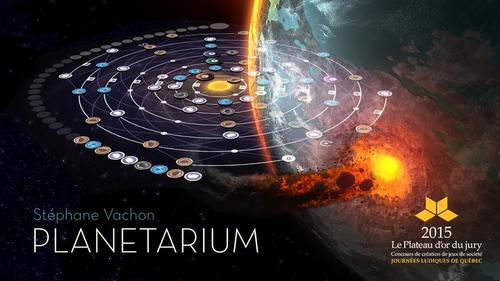Create your own solar system in Planetarium

Many people daydream about what it would be like to rule the world.
But have you ever wondered what it would be like to rule your own solar system?
Or better yet – create your own solar system from scratch?
In the upcoming game, Planetarium by Game Salute, you’ll be able to do just that.
The only catch is that the other players are trying to ruin your plans. They want to shape the matter in this new planetary system according to their own plans.
And the end result will be a blend of everyone’s plans where the player with the most points claiming victory.
Planetarium is a fun game with a great balance of strategy and luck that families throughout the galaxy will enjoy playing together.
Because if your kids enjoy Planetarium as much as our Caleb does, you’ll be controlling matter and planets for a long time to come.
How to play Planetarium
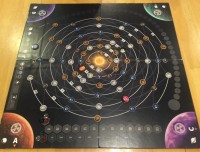
The game play in Planetarium is very straightforward.
Players take turns moving matter and planetoids around the galaxy and playing cards that evolve planets and score points.
But it’s the way matter and planets move and how cards can be played that make the game so interesting.
Set Up
Setting up the game is very simple.
To begin, players place the 4 planets (A, B, C, D) on their starting spaces on the game board.
Players then randomly place all the matter tokens on the white dots on the game board.
Each planet in the corner of the board also has their related Hostile/Habitable token placed on them Hostile side up.
Each set of cards (Low, High, and Final Evolution) is separately shuffled to create 3 decks and placed nearby.
Each player is then given a player mat and eight markers of their chosen color.
Players also begin the game with 5 cards in hand – 2 Low Evolution cards, 2 High Evolution cards, and 1 Final Evolution card (draw 2, choose 1).
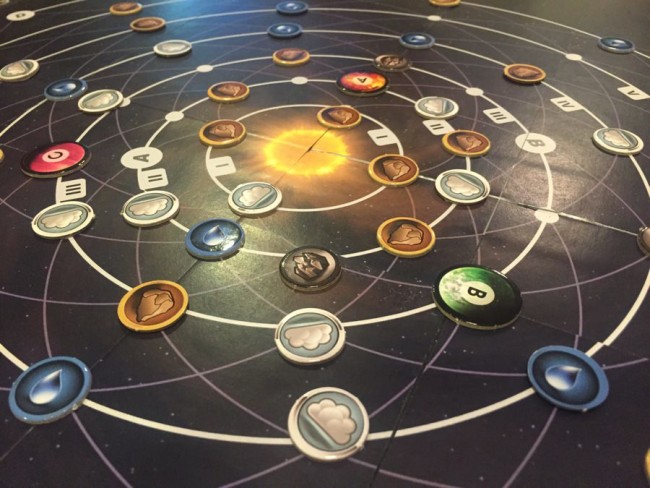
Player Turns
On a player’s turn, he/she will move one token on the board and then may play a card.
1. To move a token, a player simply chooses a planet token or a matter token and moves it one space in a clockwise direction. The tokens move along a designation line — either in the same orbit level or into an adjacent orbit along the crossover lines.
Matter tokens cannot move through or over other matter tokens.
Planets tokens can move through a space occupied by another planet token. Planet tokens can also move along its same orbit line (thick lines) as far as desired, or until it moves onto the space of a matter token.
When a matter token and a planet token collide on the same space, the player that moved the token collects the matter token. The player then places the collected matter token onto their player mat on the matching planet space.
For example, if a player moves a Gas token to a space where the planet “A” token is, the player then places the Gas token onto the “A” planet on their player mat.

2. To play a card, the player must first be able to meet the conditions listed on the left edge of the card (such as certain matter tokens). The player chooses which planet to play the card on and places it next to the board by that planet. The player also places one of their color markers on the card to indicate that they played that card.
However, to play an evolution card to a planet, not only must the player have the correct amount and type of matter tokens, but they must be from the corresponding planet on their player mat!
For example, to play an evolution card to Planet “A”, a player must already have the matter tokens stored on Planet “A” of their player mat.
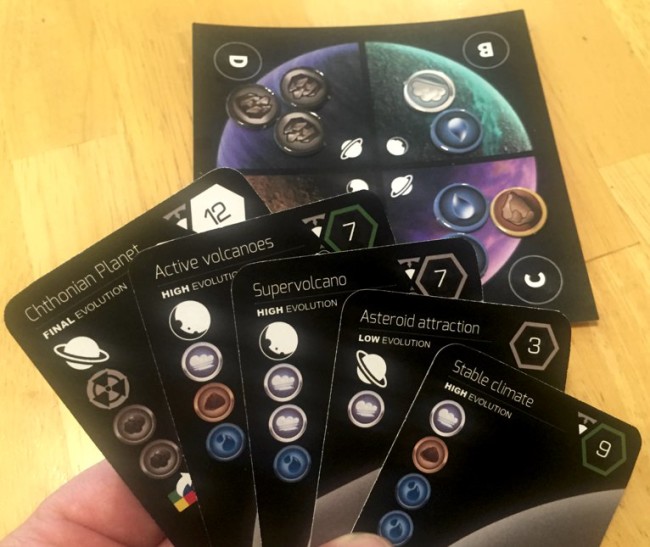
The player removes the used matter tokens from their player mat and places them on the Evolution track.

The player then scores the number of points indicated in the top right corner of the card they played by moving their markers on the score track accordingly.
If the card played has a Gravity icon on it, that player can also claim a matter token from anywhere on the board.
Only the Low and High Evolution cards can be played during the majority of the game. Final Evolution cards can only be played on a player’s final turn.
Once a player has played a card, they draw a replacement card from any deck they desire. If they choose to draw from the Final Evolution deck, they’ll draw 2 cards, choose 1 to keep, and discard the other.

In addition, the player checks to see if that planet is now Hostile or Hospitable. Each number has a colored border — Green or Grey. The total value of Hostile cards played to that planet are compared to the total value of Hospitable cards played to that planet. If one total is higher, that side of the Hostile/Hospitable token is placed up.
That ends a player’s turn and play passes clockwise to the next player.
Final Stages
When a player spends matter tokens to play a card, the used tokens are placed on the Evolution track. Once a matter token is placed on the Acceleration spot on the track, players can now move matter tokens 1 or 2 spaces on the game board.
Once a matter token is placed on the final space of the Evolution track, the final turns are triggered.
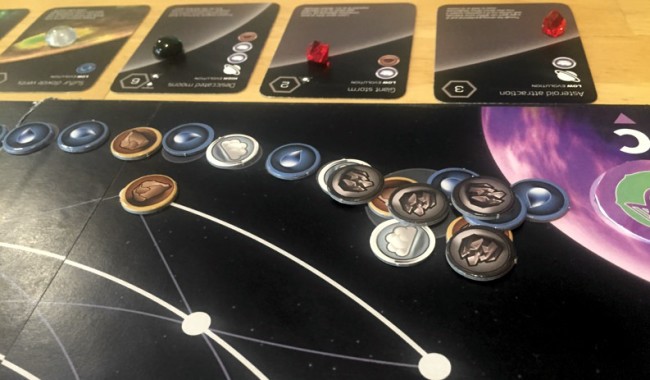
The player that placed the token may now play Final Evolution cards from their hand. Then each other player in turn order takes their final turn.
A final turn is the same as a normal turn — moving a token and playing a Low or High Evolution card. But then they can also play as many Final Evolution cards as they can.
Final Evolution cards can be worth a lot of points, but they’re also trickier to play.
To play a Final Evolution card to a planet, the player must already have played a card to that planet (as indicated by their color markers on cards played).
After players have taken their final turns and played their Final Evolution cards, the player with the most points wins the game!
Why we enjoy playing Planetarium
There are a number of reasons why we enjoy playing Planetarium.

For starters, it’s a game with both simple mechanics and interesting choices.
There isn’t a lot to remember of what to do on a turn — move a token, collect a matter token if it collides with a planet, and play one card to a planet if possible. Yet, choosing which tokens to move to collect the tokens you need in order to play the cards you have is an intriguing proposition.
Thus, players have to think ahead to which cards they want to play. Because some cards have more requirement than just spending matter tokens. Some cards can only be played on Hostile or Hospitable planets. And some cards can only be played on Terrestrial or Gaseous.
So in addition to thinking through which matter tokens to collect, players have to collect those tokens by crashing them into a planet token on the board that matches the requirements of the cards they have.
And of course, some types of matter are more rare than others. So collecting those types of tokens may be key to victory. Yet, players will still have to determine which planet they’ll need to store those tokens on for later use.
It’s those interesting choices that keep us coming back for more.
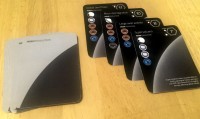
The next big reason we like playing Planetarium is that every game plays out differently.
The random distribution of the matter tokens during set up is a big contributing factor to each game playing out differently. But so are the random card draws.
Which cards a player draws will greatly determine what they’re trying to achieve. Players will have to adjust along the way to maneuver the tokens just right to accomplish their goal. And they’ll also have to choose wisely which planet to play their cards to. Because the switch of a planet from Hostile to Hospitable can swing the outcome of the game.

Which leads to another element we love about Planetarium — the balance of strategy and luck.
Pure strategy games don’t go over very well in our family. Instead, games that require some strategy but also contain elements of luck usually go over much better.
That’s because the jolt of luck in a game not only gives everyone a chance to come out victorious, but it also means that the outcome isn’t predetermined. Playing wisely will give you the edge for sure. But it’s not set in stone that you’ll win.
And the tension that luck brings to a game creates a more engaging experience.
The last element we’ll mention that we love is that the game plays very quickly.
We’ve found that most turns are spent simply moving and collecting tokens rather than playing cards. As such, there isn’t much downtime before it’s your turn again.

As the game progresses turns do take a little bit longer. That’s because tokens are removed from the board and more cards are played to planets so there’s more to think about on a turn. However, turns still clip along nicely.
Each of the times we’ve played the game has lasted about 30 minutes.
Oh, and let’s not forget that the artwork is fantastic!
We know we’ve just been playing with prototype components, so there isn’t much to look at on the cards yet. But we’ve loved the artwork of the Planetarium rulebook. And we expect the final artwork on the cards to look absolutely stellar!
How does Planetarium score on our “Let’s Play Again” game meter?
As we’ve already mentioned, if it were up to Caleb, we may never stop playing Planetarium. As soon as one game ends, he’s asking to play again and dives right into randomly setting out the matter tokens on the board.
So it’s easy to report that Planetarium scores very high on our “let’s play again” game meter.
We can’t wait to get a copy of the game when it’s published!
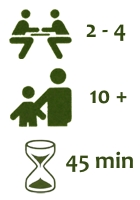 Yep, that’s right — Planetarium isn’t yet available in game stores. It’s currently raising funds on Kickstarter to be published by Game Salute.
Yep, that’s right — Planetarium isn’t yet available in game stores. It’s currently raising funds on Kickstarter to be published by Game Salute.
We very rarely talk about games that aren’t yet available in game stores. But every once in a while we discover a game that hits the mark for a great family board game. And Planetarium is such a game.
And we’re not the only ones who think so. We were happy to see that Planetarium hit their funding goal almost right out of the gate!
We highly recommend you visit the Planetarium Kickstarter page and jump in a copy of the game.
You’ll be shaping the solar system before you know it.
